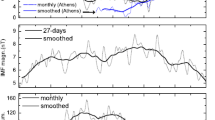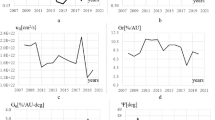Summary
Extensive air showers (EAS) with median primary energy (E m) of (1013÷1015) eV have been observed since 1970 at Mt. Norikura (2770 m above sea level; geographic latitude 36.1°N, longitude 137.6°E) in order to study a cosmic-ray sidereal daily variation of galactic origin. We report here a summary of the observed results. EAS shows a significant sidereal diurnal variation with an amplitude (0.060±0.003)% and a phase (0.8±0.3) h sidereal local time forE m≈1.5·1013eV. Sidereal semi- and tridiurnal variations also are statistically significant. These variations are proved to be of galactic origin by a method which uses the difference of two directional (eastward and westward) air shower observations. It is found that these variations are subject, as predicted by Nagashimaet al., to the annual variation due to the heliomagnetospheric modulation of the galactic anisotropy, which dominates in the rigidity region ≈1012V, and further that the annual variation changes its phase due to the polarity reversal of the polar magnetic field of the Sun, which occurs at the period of the maximum solar activity. This indicates that the anisotropy is produced by the charged cosmic rays, contrary to the expectation from the γ-ray origin hypothesis suggested by Alexeenko and Navara. With the increase ofE m, the anisotropy seems to be reduced as we have not been able to detect any significant sidereal variation in EAS withE m≈2·1014eV. This seems contradictory to the conventional conclusion that the energy spectrum of the anisotropy is flat or slightly increases with energy.
Riassunto
Sono stati osservati sciami cosmici estensivi (EAS) con energia primaria mediana (E m) di (1013⋎1015) eV dal 1970 a Mt. Norikura (2770m, latitudine geografica 36.1° N, longitudine 137.6° E) per studiare una variazione gionarliera siderale dei raggi cosmici di origine galattica. Si riporta una sintesi dei risultati osservati. EAS mostra una significativa variazione siderale diurna con ampiezza (0.060±0.03)% e fase (0.8±0.3)h in tempo locale siderale perE m∼1.5·1013eV. Le variazioni siderali semi e tri-diurne sono risultate anch'esse statisticamente significative. Si prova che queste variazioni sono d'origine galattica con un metodo che utilizza la differenza tra due osservazioni di sciami cosmici direzionali (est e ovest). Si trova che queste variazioni sono soggette, come previsto da Nagashimaet al., alla variazione annuale dovuta alla modulazione eliomagnetica dell'anisotropia galattica, che domina nella regione di rigidità ∼1012V e inoltre che la variazione annuale cambia fase a causa dell'inversione di polarità del campo magnetico polare del Sole, chesi verifica nel periodo di massima attività solare. Ciò indica che l'anisotropia è prodotta da raggi cosmici carichi, contrariamente a quanto previsto dall'ipotesi sull'origine da raggi gamma, suggerita da Alexeenko e Navara. Con l'aumento diE m, l'anisotropia sembra ridursi in quanto non siamo riusciti a rilevare una variazione siderale significativa in EAS conE m∼2·1014 eV. Questo risultato sembra in contraddizione con la conclusione convenzionale che lo spettro di energia dell'anisotropia è piatto o cresce appena con l'energia.
Резюме
Широкие атмосферные ливни со средней первичной энергией (E m), равной (1013⋎1015) зВ, наблюдались с 1970 года на г. Нарикура (2770 м над уровнем моря; географическая широта 36.1°N, долгота 137.6°E), с целяю исследовать суточное изменение сидерических космических лучей галактической природы. Предлагается обзор полученных результатов. Широкие атмосферные ливни обнаруживают значительное сидерическое суточное изменение с амплитудой (0.060±0.003)% и фазой 0.8±0.3 часа сидерического времени дляE m∼1.5·1013 эВ. Сидерические полу-и трех-суточные изменения являются также статистически заметными. Доказывается, что эти изменения имеют галактическое происхождение. Этот результат получен с помощью метода, который использует разности при наблюдениях атмосферных ливней в двух направлениях (в восточном и западном направлениях). Получено, что эти вариации подчиняются, как было предсказано Нагашима и др., годовому изменению, обусловленному гелиомагнитосферной модуляцией галактической анизотропии, которая доминирует в области жесткости ∼1012 D, и кроме того, годовая вариация изменяет фазу, в связи с реверсированием полярности магнитного поля Солнца, котороепроисходит в период максимума солнечной активности. Этот реультат показывает, что возникает анизотропия, вызванная заряженными космическими лучами, в противоположность рредсказанию Алексеенко и Навара, связанному с гипотезой происхождения γ-лучей. При увеличенииE m анизотропия, повидимому, уменьшается, так как мы не смогли зарегистрировать какого-либо существенного сидерического изменения в пироких атмосферных ливнях в случаеE m∼2·1014эВ. Это противоречит общепринятому заключению, что энергетический спектр анизотропии является пологим или слегка увеличивается с энергией.
Similar content being viewed by others
References
K. Nagashima andS. Mori:Proceedings of the International Cosmic Ray Symposium on HIgh Energy Cosmic Ray Modulation, Tokyo, Japan, 1976, p. 326 and references therein.
J. Daudin, P. Auger, A. Cachon andA. Daudin:Nuovo Cimento,3, 1017 (1956).S. Sakakibara:J. Geomagn. Geoelectr.,17, 99, (1965) and reference therein.
J. Linsley andA. A. Watson:Proceedings of the XV International Cosmic Ray Conference, Plovdiv, 1977,12, 203 and references therein.
C. E. Fichtel andJ. Linsley:Astrophys. J.,300, 474 (1986) and references therein.
S. Sakikibara, H. Ueno, K. Fujimoto, I. Kondo andK. Nagashima:Proceedings of the XIII International Cosmic Ray Conference, Denver, 1973,2, 1058.
T. Gombosi, J. Kota, A. J. Somogyi, A. Vrana, B. Betev, L. Katsarski, S. Kavlakov andI. Khirov:Proceedings of the XIV International Cosmic Ray Conference, München, 1975,2, 586.
V. V. Alexeenko, A. E. Chudakov, E. N. Gulieva andV. G. Sborshikov:Proceedings of the XVII International Cosmic Ray Conference, Paris,2, 146 (1981).
K. Nagashima, H. Ueno, K. Fujimoto, Z. Fujii, S. Sakakibara andI. Kondo:Proceedings of the XIV international Cosmic Ray Conference, München, 1975,4, 1503.
K. Nagashima, K. Fujimoto, Z. Fujii, S. Sakakibara, H. Ueno andI. Kondo:Proceedings of the XIV International Cosmic Ray Conference, München, 1975,4, 1368:K. Nagashima, S. Sakakibara, K. Fujimoto, Z. Fujii, H. Ueno andI. Kondo:Proceedings of the XV International Cosmic Ray Conference, Plovdiv, 1977,2, 154;K. Fujimoto, H. Ueno, Z. Fujii, S. Sakakibara, I. Kondo andK. Nagashima:Proceedings of the International Cosmic-Ray Symposium on High Energy Cosmic-Ray Modulation, Tokyo, Japan, 1976, p. 156;S. Sakakibara, K. Fujimoto, Z. Fujii, H. Ueno, I. Kondo andK. Nagashima:Proceedings of the International Cosmic-Ray Symposium on High Energy Cosmic-Ray Modulation, Tokyo, Japan, 1976, p. 162;S. Sakakibara, K. Fujimoto, Z. Fujii, H. Ueno, I. Kondo andK. Nagashima:Proceedings of the International Cosmic-Ray Symposium on High Energy Cosmic-Ray Modulation, Tokyo, Japan, 1976, p. 316;S. Sakakibara, H. Ueno, K. Fujimoto, Z. Fujii, I. Kondo andK. Nagashima:Proceedings of the XVI International Cosmic Ray Conference, Kyoto, 1979,4, 216;S. Sakakibara, H. Ueno, K. Fujimoto, Z. Fujii, I. Kondo andK. Nagashima:Proceedings of the International Symposium on Cosmic Ray Modulation in the Heliosphere, Morioka, Japan, 1984, p. 314.
Y. Sekido, K. Nagashima, I. Kondo, H. Ueno, K. Fujimoto, Z. Fujii andS. Sakakibara:Report of Cosmic-Ray Research Laboratory, Nagoya Univ., no. 2 (1975).
K. Greisen:Progress in Cosmic Ray Physics, Vol.3 (North-Holland Publishing Company) 2nd printing, 53 (1965).
J. Nishimura andK. Kamata:Progr. Theor. Phys.,7, 185 (1952);K. Kamata andJ. Nishimura:Suppl. Prog. Theor. Phys.,6, 93 (1958).
A. Daudin andJ. Daudin:J. Physique et le Radium,14, 169 (1953).
N. N. Efimov, D. D. Krasilnikov, S. I. Nikolsky andF. K. Shamsutdlnova:Canad. J. Phys.,46, S84 (1968).
A. L. Hodson:Proc. Phys. Soc. A,64, 1061 (1951).
S. Kawasaki:Sci. Papers Inst. Phys. Chem. Res. (Japan),66, 25 (1972).
S. Sakakibara, T. Yamada, H. Satake, Z. Fujii andK. Murakami:Proceedings, of the Cosmic-Ray Research Laboratory of Nagoya University,26, 13 (1983) (in Japanese).
K. Nagashima andH. Ueno:Rep. Ionos. Space Res., Japan,25, 212 (1971).
V. V. Alexeenko andG. Navara:Lett. Nuovo Cimento,42 321 (1985).
K. Nagashima, I. Morishita andS. Yasue:Planet. Space Sci.,30, 879 (1982);K. Nagashima, I. Morishita andS. Yasue:Planet. Space Sci.,31, 1259 (1983).
K. Nagashima andI. Morishita:Report of Cosmic Ray Res. Lab., Nagoya Univ., no. 8 (1983).
J. T. Hoeksema andP. H. Scherrer:World Data Center A for Solar-Terrestrial Phys. Rep., UAG-94 (1986).
E.g.,W. McClintock,R. C. Henry,J. L. Linsky andH. W. Moos:Astrophys. J.,225, 465 (1978);J. M. Ajello:Astrophys. J.,222, 1068 (1978).
K. Nagashima:Rep. Ionos. Space Res. Japan,25, 189 (1971).
S. Chapman andJ. Bartels:Geomagnetism, Vol.2 (Oxford University Press, Oxford, 1940), p. 611.
R. M. Jacklyn:Nature,211, 690 (1966);R. M. Jacklyn:Proc. Astron. Soc. Aust.,6, 425 (1986).
A. G. Fenton andK. B. Fenton:Proceedings of the XIV International Cosmic Ray Conference, München, 1975,4, 1482.
Yu. M. Adreyev, A. E. Chudakov, V. A. Kozyarivsky, A. M. Sidorenko, T. I. Tulupova andA. V. Voevodsky:Proceedings of the XX International Cosmic Ray Conference, Moscow, 1987,2, 22.
S. Mori, S. Sagisaka, S. Yasue andM. Ichinose:Proceedings of the XX International Cosmic Ray Conference, Moscow, 1987,4, 160.
D. J. Cutler, H. E. Bergeson, J. F. Davis andD. E. Groom:Astrophys. J.,248, 1166 (1981).
L. C. Tan:Proceedings of the XIX International Cosmic Ray Conference, La Jolla, 1985,2, 318.
K. Munakata andK. Nagashima:Proceedings of the XIX International Cosmic Ray Conference, La Jolla, 1985,5, 98.
J. Kota:J. Phys. A,8, 1349 (1975);G. Erdös andJ. Kota:Astrophys. and Space Sci.,67, 45 (1980).
S. Yasue, I. Morishita andK. Nagashima:Planet. Space Sci.,33, 1057 (1985).
G. Cini-Castagnoli, D. Marocchi, H. Elliot, R. G. Marsden andT. Thambyahpillai:Proceedings of the XIV International Cosmic Ray Conference, München, 1975,4, 1453;R. G. Marsden, H. Elliot, R. J. Hynds andT. Thambyahpillai:Nature,260, 491 (1976);M. Ichinose andK. Murakami:Proceedings of the International Symposium on High Energy Cosmic Ray Modulation, Tokyo, Japan, 1976, 291;T. Thambyahpillai:Proceedings of the XVIII International Cosmic Ray Conference, Bangalore, 1983,3, 383.
M. Bercovitch:Proceedings of the International Symposium on Cosmic Ray Modulation in the Heliosphere, Morika, Japan, 1984, 329.
Author information
Authors and Affiliations
Rights and permissions
About this article
Cite this article
Nagashima, K., Fujimoto, K., Sakakibara, S. et al. Galactic cosmic-ray anisotropy and its modulation in the heliomagnetosphere, inferred from air shower observation at Mt. Norikura. Il Nuovo Cimento C 12, 695–749 (1989). https://doi.org/10.1007/BF02511970
Received:
Issue Date:
DOI: https://doi.org/10.1007/BF02511970




